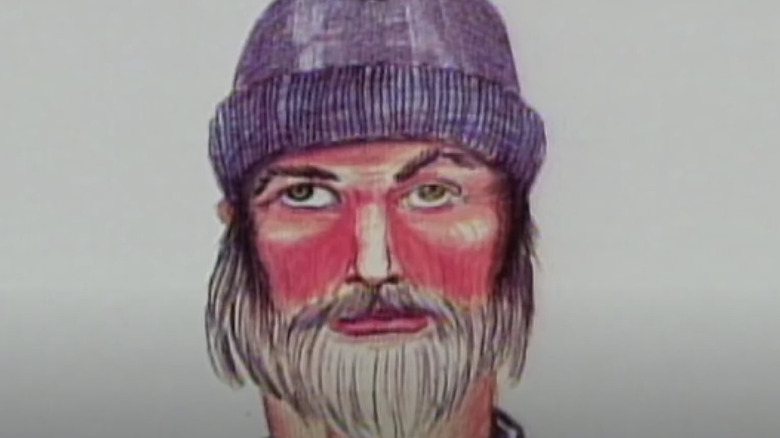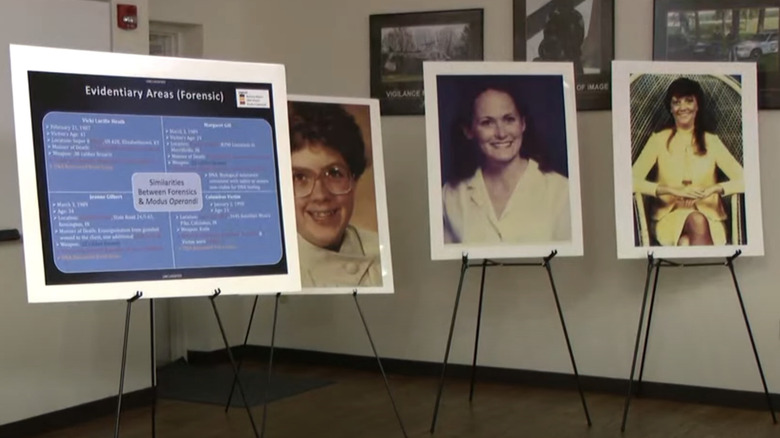Why The I-65 Serial Killer Took So Long To Identify
In the late 1980s, three women were raped and murdered at hotels along the I-65 corridor in the states of Kentucky and Indiana. At least one other woman was similarly assaulted but she escaped. She was then able to provide police with a description of her attacker, who authorities believed may be responsible for a number of other crimes in the area. Despite the best efforts of the police, the criminal — who came to be known as the "I-65 Killer" or "Days Inn Killer" — was never caught, until now (via USA Today).
The fact that the I-65 Killer is now identified with near certainty reflects the degree to which modern technology has revolutionized the way crimes are investigated. Although the past can't be changed, this new information gives answers to those who lost loved ones, as well as to anyone who survived the I-65 killer's attacks. How exactly was this serial killer finally identified all these years later? The killer's own family played a part.
How the I-65 killer would operate
The first victim of the I-65 killer was named Vicki Heath, per USA Today. After the front desk in the lobby where she worked was found left unattended, her body was discovered near a dumpster behind the hotel where she worked. The 41-year-old mother of two had been sexually assaulted and shot twice in the head. The motel had also been robbed. DNA was collected at the scene but with limited DNA technology and few DNA databases those samples turned up few leads.
The I-65 killer would kill two more women: Margaret "Peggy" Gill, 24, and Jeanne Gilbert, 34, who were also both hotel employees. A short time later, the killer was linked through DNA to one additional sexual assault in Indiana, although his true identity remained unknown. Through DNA evidence, investigators were able to connect all these crimes together. Additionally, the women were killed with the same kind of gun, a .22 caliber pistol.
At least one of the I-65 killer's victims survived
The Indiana woman who was assaulted by the I-65 killer survived the attack. For this reason, she was able to give the police a description of her assailant. He had unkempt gray hair and a beard and he was around 6 feet tall. Most notably, he had a lazy right eye, as Indiana news outlet WTHR explains. She was also able to tell the police what he was wearing and even what color his eyes were. But even with that invaluable information, authorities were unable to track him down, per Yahoo! News.
According to authorities, these are just a few of the crimes potentially linked to the "Days Inn Killer" throughout the Midwest. In the intervening years between 1990 and the announcement of the I-65 killer's true identity in April 2022, the case went cold. In response to the news that he had been identified, Indiana State Superintendent Doug Carter said (via Independent) "There are detectives in this room that have been involved in this for some form or another for literally generations. They're owed a debt of gratitude we can never possibly repay."
DNA is now used to solve cold cases
The technique that was finally able to provide the real identity of the I-65 killer is known as forensic genealogy, an approach that is helping to solve a number of cold cases throughout the country, per The New Yorker. Using this approach, investigators are able to compare DNA collected at crime scenes with DNA from surviving family members, or against DNA provided to services like Ancestry.com, among others, by those who are seeking to explore their own personal genealogy.
The next step in the process is to use that data to build a criminal's family tree and then narrow down the field of possibilities until the culprit is found. This approach is remarkably accurate, as Science Focus explains. In the case of the I-65 killer, police had his DNA samples because he had several previous run-ins with the law. Along with DNA collected at the I-65 killer crime scenes, and DNA from surviving family members, authorities made their match: the I-65 killer was named Harry Edward Greenwell (via Independent).
Who was Harry Edward Greenwell?
By the time authorities announced the real identity of the I-65 killer, Harry Edward Greenwell had been dead for roughly nine years. Greenwell was arrested several times throughout his life though, for assault, robbery, sodomy, and restraining order violations, according to IndyStar. He had even spent time in jail and on probation. In 1998, Greenwell was arrested for felony drug possession and a short time after that for more restraining order violations. He died of cancer in 2013.
Chillingly, those close to Greenwell at the time that he died seemed to know little about his criminal history, or so his obituary states (via Legacy). Greenwell was described as "a man with many friends who loved his straight-up attitude, and his willingness to help anyone. His spirit will live on in many by good deeds he offered."
His hobbies included gardening and selling his organic produce at local farmers' markets. It was written that he enjoyed travel. He was also married, had children, and was one of eight siblings according to his obituary. Born in Kentucky, he was living in Iowa when he died and had worked for the Canadian Pacific Railway for 30 years before retiring in 2010.
The victims' families now have some closure
Although Harry Edward Greenwell died in 2013 at the age of 68, the fact that he is now identified as the I-65 killer with near absolute certainty does provide the families of his victims some comfort. Indiana State Police Superintendent Doug Carter said, (via USA Today) "I hope today might bring a little bit of solace to know that the animal who did this is no longer on this Earth."
The announcement of the I-65 killer's true identity came in a press conference from federal and local law enforcement agencies, as well as the Indiana State Police. The DNA results are considered 99.99% accurate (per USA Today).
Kim Gilbert Wright, the daughter of Jeanne Gilbert who Greenwell killed, said at the press conference (via Independent), "I'd like to believe that whatever each of us defines as justice, or what each of us might define as closure, that we're all now able to share the healing process knowing the long known attacker has now been brought out of the dark, into the light."





